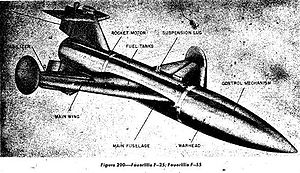Fire lily (anti-aircraft missile)
Feuerlilie was the camouflage name for a German anti-aircraft missile that was developed from 1940 and whose development was discontinued at the end of January 1945 in favor of other projects due to problems with the control and the drive section. The fire lily was built in two versions at Rheinmetall-Borsig and tested at the Rumbke rocket testing center : the F 25 with a diameter of 25 cm and the F 55 with a diameter of 55 cm. Solid- state propulsion systems of the Rheinmetall 109-505 / 515 type served as engines .
Fire lily F 25
In 1940, the Hermann Göring Aviation Research Institute (LFA) began planning a remote-controlled rocket under the code name "Feuerlilie". The research results obtained in this way should be used in the construction of anti-aircraft missiles. First, a smaller version of the fire lily (F 4,4) was created as a sample piece in order to get a short-term impression of the later flight behavior of the new defense weapon. The order from the Reich Aviation Ministry (RLM) for 25 F 25s , which were to be tested in practice in cooperation with the German Research Institute for Glider Flight (DFS) and the Reichspost Research Office (RPF), came some time later. The development of the remote control system was already well advanced by February 1943 and the high-speed tests in the wind tunnel and the completion of a shooting frame for the F 25 were almost complete. The production of the first F 25 of the pilot series, which comprised 24 samples, was progressing unexpectedly well and by July 1943 it was possible to finish another F 25 , but all of this with missing drives. That is why the first F 25 did not arrive until mid-July 1943 on the test site in Leba on the Baltic Sea . At least four F 25s were launched by mid-1944 , but the test results obtained up to then could not meet the expectations placed on the F 25 , and development of the previous versions of the F 25 was stopped before the end of 1944.
Fire lily F 55
After development of the F 25 was discontinued , the main interest at LFA Hermann Göring was the F 55 version . This was a remotely controlled supersonic rocket designed as a level wing aircraft with two-stage propulsion (launch stage: solid and flight stage: liquid).
The device was launched from an inclined mount ; later, modified 88 mm anti-aircraft mounts were also used for the launch pad . The first sample of the F 55 was already half finished in April 1942. On January 25, 1943, the Ardelt company in Breslau received the official order to build five test samples, the construction of which was completed by February 5, 1943. On March 9th, Hermann Göring approved the construction of the anti-aircraft missile, the delivery of 30 sample devices that had meanwhile been ordered was delayed due to technical problems, including the controls and the drive section.
On May 12, 1944, an F 55 A1 took off for the first time , covering a distance of 7500 m in 69 s. From October 19, 1944, there were three more take-offs on Greifswalder Oie with the F 55 A2 version , which was particularly noticeable due to its unstable flight behavior. The start of the improved F 55 A3, scheduled for October 21, 1944, was canceled due to technical problems. On November 22, 1944, the Technical Office of the RLM reduced the number of F 55 devices to 25, the number of which was again reduced to 20 sample devices of the A2 and A3 versions on December 11, 1944. The last documented attempt to fly an F 55 A2 took place on December 11, 1944 on Greifswalder Oie.
In order to accelerate further development and to achieve reliable results more quickly, it was decided on January 14, 1945 to install the unchanged drive of the Henschel Hs 293 glide bomb on the F 55 A2 and A3 and to equip the F 55 with a larger tail unit for greater flight stability . However, since the development of the fire lily was stopped at the end of January 1945, these innovations were no longer effective. In February / March 1945 there were still considerations for further developments.
Technical specifications
- Length:
F 25 - 1896 mm
F 55 - 4800 mm
- Diameter:
F 25 - 250 mm
F 55 - 550 mm
- Span:
F 25 - k. A.
F 55 - 4500 mm
- Vmax:
F 25 - 840 km / h
F 55 - 1260 km / h
- Nominal height:
F 25 - not known
F 55 - approx. 10,000 m
- Weight:
F 25 - not known
F 55 - approx. 600 kg with a payload of 100 kg
See also
literature
- Manfred Griehl: Air Force '45. Recent flights and projects. Motorbuch Verlag, Stuttgart 2005, ISBN 3-613-02474-8 .
swell
- ↑ Cf. RWWA, inventory 51-18, plan drawings from the Deutsche Forschungsanstalt für Luftfahrt eV, Braunschweig, and the Aviation Research Institute Hermann Göring, Braunschweig, regarding the "installation of the G 20" in missiles with a diameter of 550 mm and a length of 3440 mm. What is probably meant here is the fire lily project in the F 55 version.
- ↑ a b c Manfred Griehl: German anti-aircraft missiles until 1945 ; ISBN 3-7909-0768-5
- ↑ Cf. RWWA, holdings 51-17, plan drawings from the German Research Institute for Aviation eV, Braunschweig, and the Aviation Research Institute Hermann Göring, Braunschweig. Here: Documents for the M61-2 model carrier from the Hermann Göring Aviation Research Institute, Braunschweig, March 23, 1945.
Web links
- www.luftarchiv.de , image material on the fire lily

